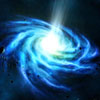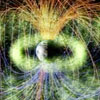Plasma And The Helical Alfvén Wave
 In order to understand the recent significant discovery of Alfvén waves being emitted from the center of black holes, one must first understand a little more about plasma, what it is although there is yet significantly more to be learned about its mysterious properties.
In order to understand the recent significant discovery of Alfvén waves being emitted from the center of black holes, one must first understand a little more about plasma, what it is although there is yet significantly more to be learned about its mysterious properties.
Plasmas are by far the most common phase of ordinary matter in the universe, both by mass and by volume. Essentially, all of the visible light from space comes from stars, which are plasmas with a temperature such that they radiate strongly at visible wavelengths. Most of the ordinary (or baryonic) matter in the universe, however, is found in the intergalactic medium, which is also a plasma, but much hotter, so that it radiates primarily as X-rays.
In 1937, Hannes Alfvén argued that if plasma pervaded the universe, it could then carry electric currents capable of generating a galactic magnetic field. After winning the Nobel Prize, he emphasized that:
In order to understand the phenomena in a certain plasma region, it is necessary to map not only the magnetic but also the electric field and the electric currents. Space is filled with a network of currents which transfer energy and momentum over large or very large distances. The currents often pinch to filamentary or surface currents. The latter are likely to give space, as also interstellar and intergalactic space, a cellular structure.
Our Sun, and all stars, are made of plasma, much of interstellar space is filled with a plasma, albeit a very sparse one, and intergalactic space too. Even black holes, which are not directly visible, are thought to be fueled by accreting ionising matter (i.e. plasma), and they are associated with astrophysical jets of luminous ejected plasma.
Artificially produced plasma can be found in plasma TV screens, fluorescent lamps, neon signs, arc lamps, plasma globe, Telsa coil arcs, semiconductor device fabrication, and laser-produced with high power lasers.
Naturally produced terrestrial plasmas include lightning, St. Elmo’s fire, upper-atmospheric lightning, ionosphere, plasmasphere, polar aurorae, and polar wind.
Space and astrophysical plasmas include the sun, stars, solar wind, the interplanetary medium (space between planets), the interstellar medium (space between star systems), the intergalactic medium (space between galaxies), interstellar nebulae, and cometary ion tail.
Plasma phenomena exhibits fractal behavior. Many of these features were first studied in the laboratory, and have subsequently been recognized throughout the universe.
Now it is being discovered that the fast-moving magnetic waves emanating from a distant supermassive black hole undulate like a whip whose handle is being shaken by a giant hand, according to a new study involving Caltech scientists, which used data from the National Radio Astronomy Observatory’s Very Long Baseline Array (VLBA) to explore the galaxy-black hole system known as BL Lacertae (BL Lac) in high resolution.
 Artist’s conception of the disk surrounding a giant black hole, with a high-speed jet. The jet is threaded by the helical magnetic field that is revealed by the BL Lac observations.
Artist’s conception of the disk surrounding a giant black hole, with a high-speed jet. The jet is threaded by the helical magnetic field that is revealed by the BL Lac observations.
The team’s findings, detailed in the April 10, 2015, issue of the Astrophysical Journal, mark the first time so-called Alfvén (pronounced Alf-vain) waves have been identified in a black hole system.
Alfvén waves are generated when magnetic field lines, such as those coming from the sun or the disk around a black hole, interact with charged particles, or ions, and become twisted, and in the case of BL Lac and sometimes for the sun, are coiled into a helix. In the case of BL Lac, the ions are in the form of particle jets that are flung from opposite sides of the black hole at near light speed.
“Imagine running a water hose through a slinky that has been stretched taut,” says first author Marshall Cohen, professor emeritus of astronomy at Caltech. “A sideways disturbance at one end of the slinky will create a wave that travels to the other end, and if the slinky sways to and fro, the hose running through its center has no choice but to move with it.”
A similar thing is happening in BL Lac, Cohen says. The Alfvén waves are analogous to the propagating transverse motions of the slinky, and as the waves propagate along the magnetic field lines, they can cause the field lines—and the particle jets encompassed by the field lines—to move as well.
It’s common for black hole particle jets to bend—and some even swing back and forth. But those movements typically take place on timescales of thousands or millions of years. “What we see is happening on a timescale of weeks,” Cohen says. “We’re taking pictures once a month, and the position of the waves is different each month.”
Interestingly, from the vantage of astronomers on Earth, the Alfvén waves emanating from BL Lac appear to be traveling about five times faster than the speed of light. “The waves only appear to be superluminal, or moving faster than light,” Cohen says. “The high speed is an optical illusion resulting from the fact that the waves are traveling very close to, but below, the speed of light, and are passing just to the side of our line of sight.”
 Cartoon of an Alfven S-wave traveling down an astrophysical jet. The jet is a conical plasma flow launched by a black hole, with a helical magnetic field (yellow coil) permeating the plasma. The wave then travels along the jet, in the direction of the plasma flow, but at a velocity determined by both the jet¹s magnetic properties and the plasma flow speed. The BL Lac jet is several light years long, and the actual wave speed is about 98% the speed of light.
Cartoon of an Alfven S-wave traveling down an astrophysical jet. The jet is a conical plasma flow launched by a black hole, with a helical magnetic field (yellow coil) permeating the plasma. The wave then travels along the jet, in the direction of the plasma flow, but at a velocity determined by both the jet¹s magnetic properties and the plasma flow speed. The BL Lac jet is several light years long, and the actual wave speed is about 98% the speed of light.
Co-author David Meier, a visiting associate in astronomy and now-retired astrophysicist from JPL, added, “By analyzing these waves, we are able to determine the internal properties of the jet, and this will help us ultimately understand how jets are produced by black holes.”
Other authors on the paper, “Studies of the Jet in BL Lacertae II Superluminal Alfvén Waves,” include Talvikki Hovatta, a former Caltech postdoctoral scholar; as well as scientists from the University of Cologne and the Max Planck Institute for Radio Astronomy in Germany; the Isaac Newton Institute of Chile; Aalto University in Finland; the Astro Space Center of Lebedev Physical Institute, the Pulkovo Observatory, and the Crimean Astrophysical Observatory in Russia. Purdue University, Denison University, and the Jet Propulsion Laboratory were also involved in the study.
Original Article “Distant Black Hole Wave Twists Like Giant Whip” by Ker Than
Posted in Science For The New Agewith 1 comment.






The sun is a massive planet surrounded by a ‘cloud’ of plasma (photosphere) which produces illumination. The photosphere corresponds with earth’s intensely electromagnetically energetic ionosphere. The mega-planet sun is replete with frozen continents and oceans of liquid hydrogen. The sun is a natural superconducting-super collider that feeds off hydrogen gas evaporated from the liquid hydrogen oceans below. Sunspots occur due to sub-(cryogenic) sea volcanic eruptions which volatilize the liquid hydrogen, thus creating an over pressurization of the atmosphere contained beneath the photosphere. This excessive pressurization results in a breach in the photosphere (sunspot), acting as a relief valve. When the nascent hydrogen gas billows forth from the sunspot, it comes in contact with the intense heat and magnetic fields in the photosphere which acts as a supercollider. These gasses then rotate at relativistic speeds in opposing directions due to polarization and collide, thus producing thermo nucleation known as a Coronal Mass Ejection.